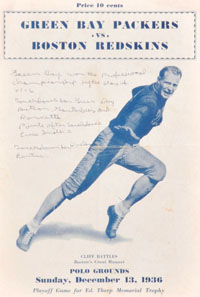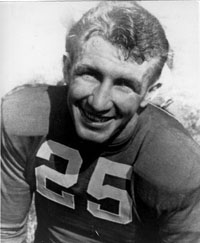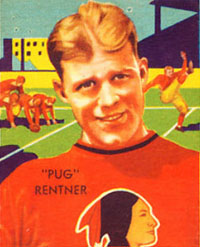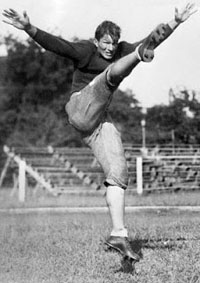|
NFL Championship Games
1936: Green Bay Packers @ Boston RedskinsThis series covers the history of the NFL through the prism of its yearly championship games.
Note: The gray boxes contain asides that provide interesting material but could be skipped without losing the continuity of the article.
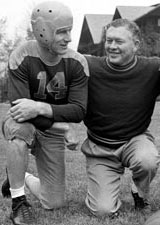
Don Hutson and Curly Lambeau
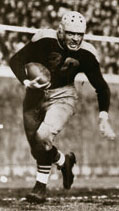
Clarke Hinkle
|
Green Bay WI was a charter member of the National Football League in 1921.
- The player-coach of the original team, Earl "Curly" Lambeau, still directed the Packers in 1936 when they won the Western Division with a 10-1-1 record, best in the league by 1 1/2 games over their archrivals, the Chicago Bears.
- The Packers had reached the top in Don Hutson's second year with the club. The "Alabama Antelope" led the NFL in receptions with a record 34 (20 more than his nearest pursuer), in receiving yards with 536 (+122 over #2), and receiving touchdowns with eight. No one had ever seen a receiver so swift and graceful with sure hands to boot. He was also an outstanding defensive back.
- Hutson helped QB Arnie Herber amass an incredible 1,239y through the air, almost 400 more than anyone else in the league. Throw in tough FB Clarke Hinkle who averaged 4.76ypc and you can understand why the Pack led the league in scoring with 248 points, 26 more than the Bears. Curly considered Hinkle the superior of Chicago's great Bronko Nagurski.
- One writer described how Lambeau built his offense around Hutson: Coach Curley Lambeau used him out wide ... in a one-man spread. So proficient is Hutson in the art of nailing all tosses that practically every team in the league has had to use two men to cover him, thus leaving someone else unguarded. This Hutson-spread also confuses the defense against ground plays, since the backersup are tricked out of position and vulnerable holes are thus opened up.
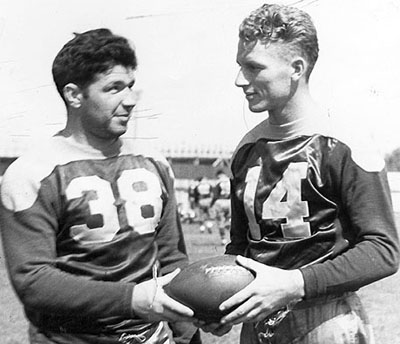
Arnie Herber and Don Hutson
Lambeau traveled more widely to scout college players than any other NFL coach. He had first seen Hutson play in the 1935 Rose Bowl when Alabama, coached by Frank Thomas, Curly's teammate at Notre Dame, trounced unbeaten Stanford.
Signing Don became trickier than Curly expected.
- Before Alabama left for Pasadena, the owner of the Brooklyn Dodgers, Shipwreck Kelly, came down to Tuscaloosa and got Don to promise to give him the opportunity to match any offer he received from another club.
- The Packers were among many teams to make offers. But all dropped out until only Green Bay and Brooklyn were left. When Curly raised his bid to $300 a game, Don telegraphed the amount to Shipwreck, as he had done for all offers to that point, but didn't hear back from Kelly, who was on vacation.
- So Don signed a contract with Green Bay. When Shipwreck showed up in Tuscaloosa, he explained what had happened and asked another chance to match Curly. So Hutson signed a contract with the Dodgers also.
- Commissioner Joe Carr would have to decide which contract was valid. It came down to a simple matter of which one reached the league office in New York first. And that was Green Bay's.
- Hutson later called the timing the biggest break I ever got in football. The reason is that Brooklyn was a grind-it-out team ... But at Green Bay, they had a real good passer in Arnie Herber, and Lambeau was a very pass-oriented coach.
- When Don reported to Green Bay, Curly asked him to keep quiet about how much he made. He even gave his star end two checks after every game, $150 each from two different banks.
|
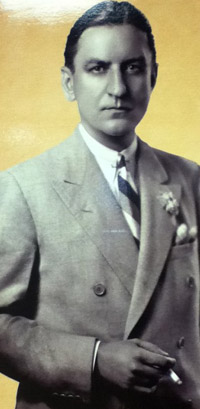 George Preston Marshall
George Preston Marshall
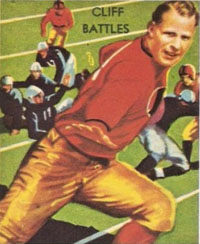
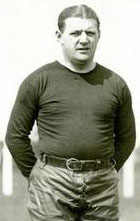
Bert Bell
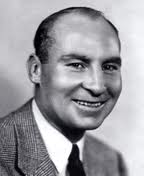
Coach Ray Flaherty

Wayne Millner
|
Green Bay's opponent, by contrast, was a relative newcomer to the NFL.
- George Preston Marshall, who made a fortune in the laundry business, founded the franchise in 1932.
- Playing the first season as the Boston Braves at the home of the city's National League baseball team, Marshall's team went 4-4-2 and lost $46,000. As a result, he lost all his partners in the enterprise.
- Full of ideas and not at all bashful, George convinced his fellow owners to adopt a number of changes that made pro football much more interesting. One change involved dividing the league into East and West and having the winners play for the championship.
- Now the sole owner, George changed his club's nickname to the Redskins, its colors to burgundy and gold, and moved their games to Fenway Park. However, they continued at the .500 level for '33 and '34 before dropping to 2-8-1 the next season.
Interested in marketing his team as much as or more than improving its quality, Marshall went all-out with the indian motif.
- He hired William "Lone Star" Dietz as his coach. Dietz had played for Pop Warner at the famous Carlisle Indian School and later coached Washington State to the Rose Bowl.
- Marshall also recruited four Indian players from the Haskell Institute.
- He required Dietz and all the players to wear Indian feathers and war paint before home games and even do an Indian dance to entertain the customers.
- Star HB Cliff Battles recalled: The first game at Fenway Park is one that anybody involved with the club at the time will never forget. We had to put on war paint and makeup. Before the game we all had to pose in feathers and headdresses. During the game the paint bothered some of the boys because it clogged their pores. The whole thing was so overdone it was embarrassing.
- George also assembled a 65-piece marching band arrayed in Indian headdresses to provide a college atmosphere. (The band still plays at Redskins home games.)
- Marshall also roamed the sideline during games, suggesting plays and giving instructions to substitutes entering the game.

Fenway Park set up for football; note goal posts on goal lines. For the '36 campaign, the NFL instituted the draft of college players with the teams picking in reverse order of finish.
The idea was pushed by Philadelphia owner-coach Bert Bell, who was tired of being outbid for players by richer franchises like the Giants and Bears.
- The first NFL draft, held in Philadelphia on February 8, 1936, consisted of nine rounds.
- The status of pro football was such that many draftees were not interested in playing in the NFL. The biggest snub came from the first Heisman Trophy winner.
- With the #1 pick, the Eagles chose Jay Berwanger of Chicago, but he demanded $15,000 ($1,000 a game, an enormous sum when the average player made less than $100 a contest). So Bell traded his rights to the Bears, who couldn't agree to terms with him either. (Berwanger later expressed regret that he didn't agree to George Halas's final offer of $13,500.)
- Of the 81 players selected in that first draft, only 24 signed with NFL teams. Poor Bert Bell couldn't win for losing. Not a single one of his nine picks joined his team.
- The Redskins, picking second each round, selected four players who were not superstars but still contributed to their Eastern championship run: Round 1 - Riley Smith BB (Alabama), Round 3 - Ed Smith FB (NYU), Round 7 - Don Irwin FB (Colgate), Round 8 - Wayne Millner E (Notre Dame).
Millner, born in the Boston suburb of Roxbury, went into pro football for two reasons: First, for the money since the best offer he had out of college was $25 a week to sell insurance and, secondly in his own words, I wanted to be a pioneer in modern pro football for the Notre Dame guys. We had some men in the game in the early days, but most of our players who stayed in football in the thirties went into college coaching.
- Even more importantly, Marshall hired a new coach: Ray Flaherty, just retired from being captain and an assistant coach for the New York Giants. Ray would construct a Hall of Fame career on the Redskins sideline. Flaherty insisted on a clause in his contract that required the owner to stay off the sideline during games.
- Millner teamed with the other end, Charlie Malone, to improve Boston's passing game right away as he snagged 18 receptions.
Confident of better results on the gridiron and therefore larger crowds, Marshall raised ticket prices for 1936, from 55 cents to $1.10.
- After nine games, Boston stood at a mediocre 4-5. But they won their next two to set the stage for what in effect was the East championship game the final week against the 5-5-1 Giants, who could win the division by upending the 6-5 Redskins.
- Sparked by Battles' 75y runback of a punt through almost ankle-deep mud in the Polo Grounds, the Indians (as journalists often called them) won 14-0 before a soaked, chilled crowd of 20,000.
- The defeat ended the Giants' streak of winning all three East titles since the league split into divisions.
Marshall lost any credibility he had left with the Boston fans when he reneged on a promise he had made in August.
- Expressing optimism about his team's chances for capturing the division and knowing that it was the East champion's turn to host the playoff, he pledged to play the NFL title game right in Fenway Park, if we have to play it in three feet of snow. Boston deserves that playoff game, and Boston is going to get it before I quit.
- However, George, upset that only 4,800 has turned out in Fenway Park for the last home game and still losing money in Beantown, decided to ask the league for permission to move the championship game to the Polo Grounds. The announcement was hardly a surprise since the football bleachers at Fenway Park had been taken down.
- The next day he received a favorable decision, as the Associated Press reported: By mutual consent of the owners, coaches and rival players, the game was transferred from Boston to New York because it is believed it will attract a larger turnout here, thus fattening the players' pool. Apathy on the part of Boston fans is already reported to have cost Owner George Marshall almost $30,000 this season and he is seriously considering shifting the franchise to some other city.
- George even transported his team to the Westchester Country Club in Rye NY to practice on a polo field in preparation for the clash with the Packers.
- Marshall had effectively burned his bridges behind him and would move his team to Washington D.C. just a few days after the title clash.
Holding the game at a neutral site would serve as a barometer for the popularity of pro football in the northeast.
- If the game drew a crowd similar to what the first three title contests had drawn in home parks, the owners could rightly claim that fans wanted to see their product regardless of who was playing.
- So much would depend on the weather, which had plagued the previous two championship games in New York and Detroit. Inclement conditions might reduce the crowd but was considered an advantage for the Redskins against the highpowered Packers.
- A little discussed advantage would prove quite valuable for Green Bay - an edge in the kicking game.
- The two teams met twice during the regular season with the Packers taking both clashes. However, in the second game in Boston, the Skins held the visitors to a scant 19y on the ground and almost pulled off an upset. But an even 200y through the air allowed the Pack to escape with a 7-3 victory.
- The only regular for either team who would miss the fray was G Eddie Kahn of Boston.
- Packer fans relished the idea of showing the nation that a team from a midwest city of only 40,000 could defeat a squad representing the populous Boston-Washington corridor.
|
1936 Green Bay Packers
| # |
Player |
Pos. |
Wgt. |
Hgt. |
College |
Exp. |
| 3 |
Paul Miller |
HB |
175 |
5-10 |
South Dakota State |
1 |
| 4 |
Herm Schneidman |
QB |
205 |
5-10 |
Iowa |
2 |
| 5 |
Bob Monnett |
HB |
181 |
5-8 |
Michigan State |
4 |
| 14 |
Don Hutson |
E/DB |
180 |
6-1 |
Alabama |
2 |
| 16 |
George Sauer |
HB |
208 |
6-2 |
Nebraska |
9 |
| 18 |
Hank Bruder |
BB/DB |
197 |
6-0 |
Northwestern |
6 |
| 22 |
Milt Gantenbein |
E |
208 |
6-0 |
Wisconsin |
6 |
| 29 |
Joe Laws |
HB |
180 |
5-9 |
Iowa |
3 |
| 33 |
Cal Clemens |
FB |
195 |
6-1 |
Southern California |
1 |
| 38 |
Arnie Herber |
TB |
205 |
6-1 |
Regis |
7 |
| 39 |
Tony Paulekas |
C |
207 |
5-10 |
Washington & Jefferson |
1 |
| 40 |
Bernie Scherer |
E |
185 |
6-1 |
Nebraska |
1 |
| 41 |
Clarke Hinkle |
FB |
202 |
5-11 |
Bucknell |
5 |
| 43 |
George Svendsen |
C/LB |
224 |
6-4 |
Minnesota |
2 |
| 51 |
Lon Evans |
G/T |
223 |
6-2 |
Texas Christian |
4 |
| 52 |
Tiny Engebretsen |
G/T |
228 |
6-1 |
Northwestern |
5 |
| 53 |
Lou Gordon |
T/G |
215 |
6-5 |
Illinois |
7 |
| 54 |
Swede Johnson |
FB |
192 |
5-10 |
Marquette |
5 |
| 55 |
Johnny McNally (Blood) |
HB |
190 |
6-0 |
St. John's (MN) |
8 |
| 57 |
Ade Schwammel |
BB |
232 |
6-2 |
Oregon State |
3 |
| 58 |
Champ Seibold |
T/G |
230 |
6-4 |
Wisconsin |
3 |
| 59 |
Frank Butler |
C/LB |
246 |
6-3 |
Michigan State |
3 |
| 60 |
Walt Kiesling |
G/T |
249 |
6-3 |
St. Thomas |
11 |
| 61 |
Ernie Smith |
T |
221 |
6-2 |
Southern California |
2 |
| 63 |
Buckets Goldenberg |
QB |
212 |
5-10 |
Wisconsin |
4 |
|
1936 Boston Redskins
| # |
Player |
Pos. |
Wgt. |
Hgt. |
College |
Exp. |
| 11 |
Ernie Pinckert |
WB/DB |
195 |
6-0 |
Southern California |
5 |
| 12 |
Eddie Britt |
FB/DB |
205 |
6-2 |
Holy Cross |
1 |
| 13 |
Ed Justice |
WB/DB |
205 |
6-3 |
Gonzaga |
1 |
| 14 |
Sam Busich |
E |
190 |
6-3 |
Ohio State |
1 |
| 15 |
Jim Barber |
T |
215 |
6-3 |
San Francisco |
2 |
| 16 |
Heinie Weisenbaugh |
HB/DB |
195 |
5-11 |
Pittsburgh |
2 |
| 17 |
Turk Edwards |
T |
260 |
6-2 |
Washington State |
5 |
| 18 |
Eddie Kahn |
G |
195 |
5-9 |
North Carolina |
2 |
| 19 |
Charlie Malone |
E |
200 |
6-4 |
Texas A&M |
3 |
| 20 |
Cliff Battles |
TB |
195 |
6-1 |
West Virginia Wesleyan |
5 |
| 21 |
Les Olsson |
G |
220 |
6-0 |
Mercer |
3 |
| 22 |
Gail O'Brien |
T |
220 |
6-1 |
Nebraska |
3 |
| 23 |
Don Irwin |
HB |
200 |
6-0 |
Colgate |
1 |
| 24 |
Frank Bausch |
C/LB |
215 |
6-3 |
Kansas |
3 |
| 25 |
Mark Temple |
HB |
175 |
5-10 |
Oregon |
1 |
| 26 |
Victor Carroll |
T/G |
215 |
6-3 |
Nevada-Reno |
1 |
| 27 |
Larry Siemering |
C/LB |
210 |
6-3 |
San Francisco |
2 |
| 29 |
Jim Karcher |
G |
207 |
6-0 |
Ohio State |
1 |
| 30 |
Flavio Tosi |
E |
195 |
6-2 |
Boston College |
3 |
| 31 |
Pug Rentner |
FB/DB |
195 |
6-1 |
Northwestern |
3 |
| 32 |
Bob McChesney |
E |
195 |
6-2 |
UCLA |
1 |
| 34 |
Steve Sinko |
T/G |
23- |
6-4 |
Duquesne |
3 |
| 35 |
Riley Smith |
BB/LB |
200 |
6-2 |
Alabama |
1 |
| 36 |
Ed Smith |
FB/DB |
210 |
6-2 |
NYU |
1 |
| 40 |
Wayne Millner |
E |
190 |
6-0 |
Notre Dame |
1 |
|
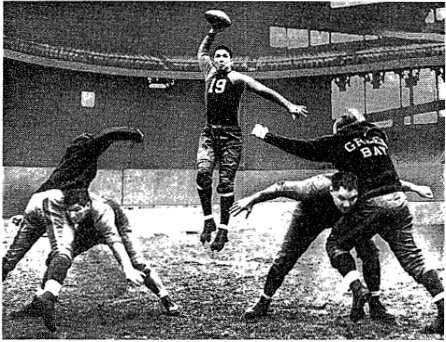
Arnie Herber practices passing the day before the big game.
Note the method of blocking - was this just for the staged picture or did they
really do it that way
when you couldn't even touch the defender with your hands?
|
|
|
A perfect day for football dawned bright and clear after a week of rain and helped bring out 29,545 spectators. The field, which had been covered by the tarpaulin all week, provided solid footing.
- Quarter 1
Fans had barely settled into their seats when the Packers pulled one of their copyrighted dazzling pass plays. The Redskins received the kickoff and started to move, but Riley Smith coughed up the pigskin, Lou Gordon recovering for the Pack on their 46. George Sauer gained two at right tackle, then Hinkle three more over center. On third down, Herber dropped back 10y behind perfect protection and spotted Hutson running easily with his deceptive loping stride straight down the field. Don used his change of pace to get a full stride behind Riley Smith. Arnie's beautiful throw dropped down over Hutson's shoulder into his sure hands at the 20, and he ran into the end zone without a finger laid on him. Ernie Smith's PAT made it 7-0. If anyone expected the Redskins to roll over after the haymaker, especially after they lost speedy Cliff Battles for the afternoon with a knee injury just four minutes into the game, they were sadly mistaken. Instead, after an exchange of punts, they marched 78y. Pug Rentner, former Northwestern All-American, picked up 12 on two thrusts. Then a long, lazy pass from Don Irwin to Ed Justice added 32 more to the Green Bay 34. The roar from the crowd indicated that Redskin fans outnumbered Packer rooters. Six more relentless plays put the pigskin on the one as the teams changed ends. Packers 7 Redskins 0
First quarter action
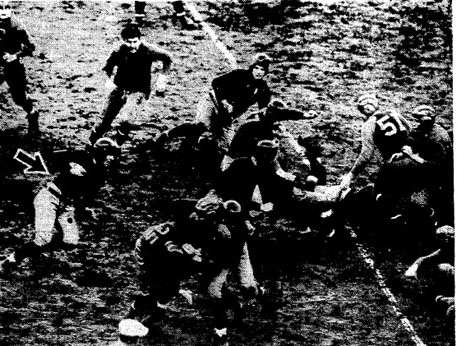
Cliff Battles (arrow) carries shortly before being injured.
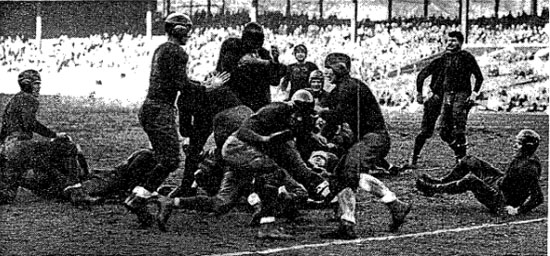
Don Irwin is stopped for no gain near the goal line.
- Quarter 2
On the first play, Rentner cut back off right tackle for the touchdown. However, Riley Smith missed the extra point, his first failure in his last 15 attempts. The miscue looked like a tragic mistake as the half ended with no more scoring. The closest either side came to adding points was a missed field goal by Smith from the Green Bay 29. Packers 7 Redskins 6
Second Quarter Action
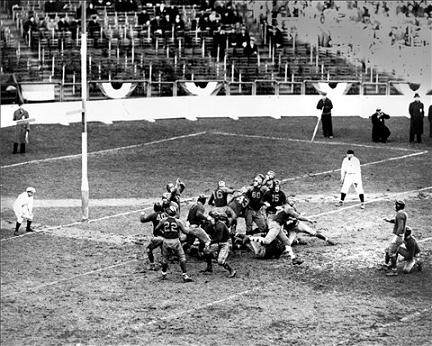
Riley Smith misses PAT after Redskins' touchdown.
|
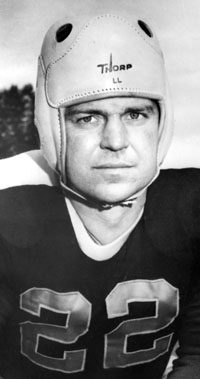
Milt Gantenbein
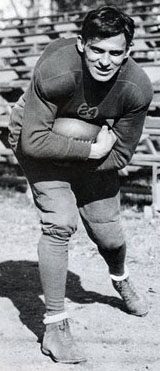
Johnny McNally
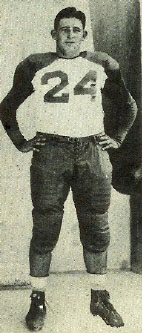
Lon Evans

Bob Monnett
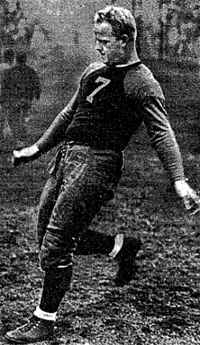
Tiny Engebretsen
|
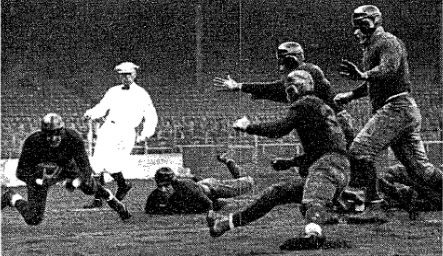
Hinkle knocked out of bounds.
- Quarter 3
According to a Milwaukee writer, the Packers played some of their greatest football of the season in the second half. Just as they scored early in the first half, Green Bay struck again with only a few minutes gone. With the ball on the 25 after the kickoff, Herber threw down the middle to E Milt Gantenbein for 14. Then Arnie connected on another long one, this time to John Victor McNally Jr., known to football fans as the legendary Johnny Blood. The 33-year-old veteran went straight down the field with Irwin, ten years younger, covering him but not knowing whether the "old man" was a decoy or the genuine article. Johnny cut to his left, then turned upfield again. He never gave any indication that he was the intended receiver until Herber had thrown the ball, which traveled 65y in the air, wobbling enroute. Blood had to swing to his left and chop his stride to pull it down at the 10. That pause allowed Irwin to pound Johnny out of bounds on the three to complete a sensational 52y play. Three snaps later, though, the Packers found themselves still at the four facing 4th and goal. Eschewing a field goal, Herber hit Gantenbein in the end zone. The Redskins concentrated so much on Hutson and Blood in the flat that they left the middle wide open. Ed Smith's second conversion gave Green Bay an eight-point lead which, with the two-point conversion far in the future, meant Boston would need two scores. During the period, the Hub City eleven lost another key player. C Frank Bausch, a bulwark at linebacker, became embroiled in fisticuffs with Frank Butler, the Green Bay sub C. Both were ejected. According to Arthur Daley of the New York Times, that cost Ray Flaherty's young men dearly because Larry Simmering, Bausch's understudy, spins back a "hard" ball that the backs could not handle. They fumbled handcuffing snaps thrice and poor punt snaps led to two blocks. Packers 14 Redskins 6
- Quarter 4
The Packer defense continued to dominate the Skins, holding them without a first down in the second half. Early in the period, with Boston punting from their 20, a bad snap allowed Lon Evans to block the ball, with Hutson beating everyone to it on the two. After Hinkle could only halve the distance to the goal line, Bob Monnett avoided the mass in the middle by wheeling around right end to pay dirt. This time, Tiny Engebretsen took care of the conversion. (Teams needed several kickers because substitution rules often prohibited the #1 conversion man from entering the game after a score unless the coach used a timeout.)
Each team lost a touchdown it thought it had before the game ended. First, Redskin E Charlie Malone got a hand on a sideways pass from Herber to Joe Laws, picked it up, and rambled 70y to pay dirt. However, the officials ruled the play an incomplete forward pass. Later, Monnett connected with Cantenbein with a pass in the flat, and Milt raced 25y into the end zone. However, an anxious tackle had pulled out of the line too quickly to get out and block. Finally, Ernie Smith blocked another of Riley Smith's punts, Tony Paulekas recovering on the 14. But a succession of passes just missed, and Boston took over.
FINAL SCORE: PACKERS 21 REDSKINS 6
The statistics accentuated the difference in the passing game between the two contestants.
- Herber completed 6-of-13 for 129y, and Hutson snared five of seven tossed in his direction. Altogether, the Packers gained 153y through the air and 71 on the ground for a total of 232y.
- Meanwhile, the Redskins, behind most of the game, connected on only seven of 27 aerials for 81y and ran for just 66 more. They actually led in first downs, 8-7, but all eight came in the first 30 minutes.
View brief footage of the 1936 Championship Game
49 seconds of additional footage
Some more video
The Packers took the Ed Thorpe Trophy home to share with their ecstatic fans.
- The players split 60% of the gate of $33,471, with each Packers earning about $250 and the Skins about $180 apiece. (About 5,000 of those in the stands were youngsters who paid only 40 cents each.)
- Dignitaries in attendance included Giants owner Jack Mara and his coach, Steve Owen, Bears' head man George Halas, Bert Bell of Philadelphia, and other owners and coaches.
1936 NFL Champions
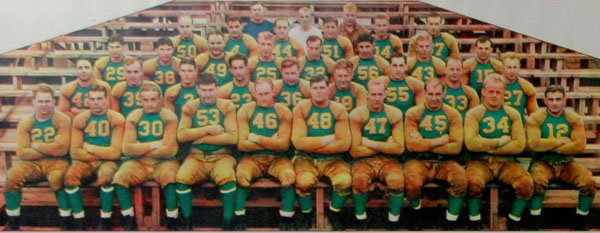 References: Championship: The NFL Title Games plus Super Bowl, Jerry Izenberg (1970)
What a Game They Played, Richard Whittingham (1984)
Showdown: JFK and the Integration of the Washington Redskins, Thomas G. Smith (2011)
|
|
|



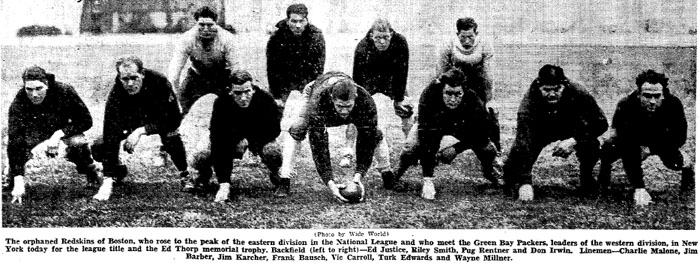




 George Preston Marshall
George Preston Marshall 



